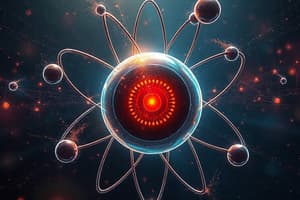Podcast
Questions and Answers
According to Dalton's atomic theory, what are atoms?
According to Dalton's atomic theory, what are atoms?
- Indivisible particles with varying weights for each element
- Particles that combine in non-whole number ratios
- Identical particles for each element that cannot be divided further (correct)
- Tiny particles that can be divided into smaller subunits
What did J.J. Thomson's plum pudding model propose?
What did J.J. Thomson's plum pudding model propose?
- Electrons are embedded in a positively charged medium like plums in a pudding (correct)
- Electrons are located outside the atom in a cloud-like structure
- Electrons move in well-defined orbitals around the nucleus
- Atoms consist of a dense central nucleus surrounded by orbiting electrons
What did Rutherford's scattering experiments using alpha particles reveal about atoms?
What did Rutherford's scattering experiments using alpha particles reveal about atoms?
- Electrons occupy most of the atom's mass
- The atom is mostly empty space with a dense positively charged nucleus (correct)
- Electrons and protons are evenly distributed throughout the atom
- The nucleus is composed of protons and electrons
How does atomic size change as you move across a period from left to right?
How does atomic size change as you move across a period from left to right?
What happens to electronegativity as you move down a group on the periodic table?
What happens to electronegativity as you move down a group on the periodic table?
What are the three main components that make up an atom?
What are the three main components that make up an atom?
Which particles reside within the nucleus of an atom?
Which particles reside within the nucleus of an atom?
What is the general charge of protons, electrons, and neutrons?
What is the general charge of protons, electrons, and neutrons?
What is an isotope?
What is an isotope?
What does atomic theory propose about matter?
What does atomic theory propose about matter?
Flashcards are hidden until you start studying
Study Notes
Structure of the Atom
The structure of the atom is a fascinating subject that has been explored extensively since scientists first began studying matter. This article will delve into the basics of atoms, atomic theory, and the periodic table of elements, providing you with a comprehensive understanding of these fundamental concepts.
Atoms
Atoms are the basic building blocks of all matter. They consist of three main components: protons, neutrons, and electrons. Protons and neutrons reside within the nucleus of an atom, while electrons orbit around it in shells called electron shells or energy levels. Electrons are negatively charged particles, while protons have a positive charge, and neutrons carry zero electric charge.
Isotopes
Isotopes are atoms of the same element that have different numbers of neutrons in their nuclei. For example, carbon has three naturally occurring isotopes: Carbon-12, which has six neutrons; Carbon-13, which has seven neutrons; and Carbon-14, which has eight neutrons. Each isotope has its own unique properties due to the number of protons and neutrons in its nucleus.
Atomic Theory
Atomic theory refers to the concept that all matter consists of discrete units called atoms, which cannot be divided any further without losing the properties of the substance. There have been several models of atomic theory throughout history, each based on empirical evidence and mathematical calculations. Some significant developments in atomic theory include:
- Dalton's atomic theory: John Dalton proposed that all matter is made up of tiny indivisible particles called atoms, which are identical for each element. He also suggested that compounds form when two or more elements combine in whole-number ratios by weight.
- Thomson's plum pudding model: J.J. Thomson discovered the electron, leading him to propose the "plum pudding" model, where electrons were embedded in a positively charged medium. However, this model could not explain the stability of the atom.
- Rutherford's nuclear model: Ernest Rutherford conducted scattering experiments using alpha particles, demonstrating that most of the mass and positive charge of an atom was concentrated in a small central region known as the nucleus. Most electrons were found to move in well-defined orbitals surrounding the nucleus, forming the modern atomic model.
Periodic Table of Elements
The periodic table of elements is a chart that organizes chemical elements by increasing atomic number, which corresponds to the number of protons in an element's atomic nucleus. Elements are arranged horizontally in rows called periods, and vertically in columns called groups. The table shows trends related to an element's chemistry, such as its reactivity or the type of bonds it forms with other elements.
Each element has a specific location on the periodic table, determined by its atomic number. As you move from left to right across a period (going from Group 1 to Group 18), the atomic size generally decreases, and the electronegativity increases. Moving down a group (from Group 1 to Group 18) often results in an increase in atomic size and a decrease in electronegativity.
Understanding the structure of the atom, including its composition, the development of atomic theories, and the organization of elements in the periodic table, provides valuable insights into the fundamental nature of matter and how it behaves chemically.
Studying That Suits You
Use AI to generate personalized quizzes and flashcards to suit your learning preferences.




